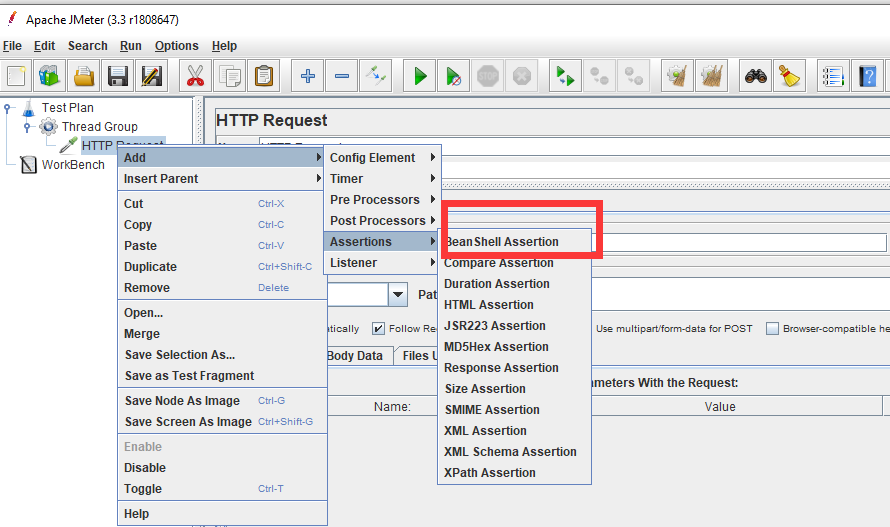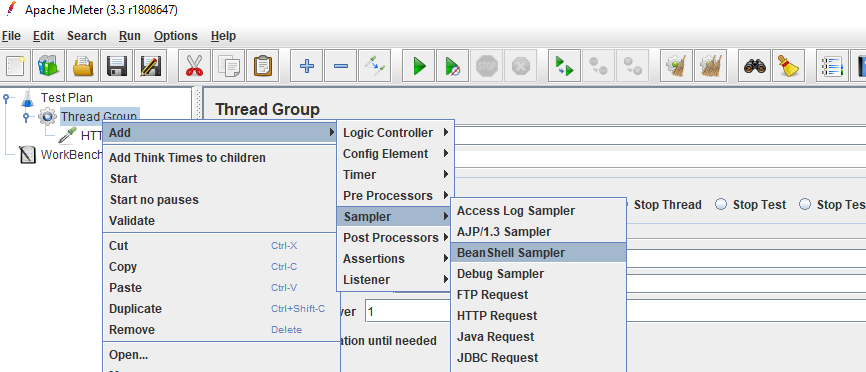代码始终比工具要灵活,Bean Shell就是一个jmeter中可以融合代码的工具
目录
1、jmeter中的Bean Shell工具
2、beanshell之断言
3、beanshell之sample
1、jmeter中的Bean Shell工具
- jmeter中有很多Bean Shell插件供使用,方便自己写代码实现工具的功能扩展,如:
- jmeter常用内置变量和方法
log.debu("调试信息")
log.info("响应状态码" + ResponseCode)
log.warn("警告信息")
log.error("出错信息")
2、beanshell之断言
第一步:如果是json格式的response,则需要先下载json包放入jmeter的/lib/ext
json.jar下载地址:链接: https://pan.baidu.com/s/1fWdO6qA8c4qZQmrlvIGKsA 提取码: y3d4
除了json.jar外还有Fastjson和gjson,后续研究好了再补充
第二步:使用Bean Shell断言工具

第三步:编写脚本
import org.json.*; //导入org.json包 String response = prev.getResponseDataAsString(); //获取响应数据 JSONObject responseJson = new JSONObject(response); //转为JSON对象 String message = responseJson.getString("message"); //获取key为message的value log.info("响应message字段:" + message); if(message.equals("登陆成功")){ Failure=false; //断言成功 log.info("登陆成功"); } else{ Failure=true; //断言失败 FailureMessage="登陆失败; }
注:Failure=false;这个断言表示成功
3、Bean Shell之Sample
- 使用Bean Shell Sample保存变量的值
第一种:使用
import java.io.*; public static void execParam(){ String getdata = vars.get("assess_token"); String filename = "D:/token.txt"; // file path try{ File file = new File(filename); if (!file.exists()){ file.createNewFile(); } FileOutputStream fos = new FileOutputStream(filename,true);//true superaddition fos.write(getdata.getBytes()); fos.close(); }catch(IOException e) { e.printStackTrace(); } } execParam();
import java.io.*;
FileWriter fstream=new FileWriter("D:/token.txt",true);
BufferedWriter out =new BufferedWriter(fstream);
out.write("${assess_token}");
out.write(System.getProperty("line.separator"));
out.close();
fstream.close();
- 使用Bean Shell Sampler导入自己写的方法


有三种方式可以导入自己写的方法
第一种:Bean Shell Sampler使用外部的.java文件,使用source导入
source("D:\Myclass.java"); int res=new Myclass().add(3,8); vars.put("add",res.toString());
第二种:
addClassPath("d:\"); //引入class文件 import test.Myclass; //导入类名 int res =new Myclass().add(6,8); //调用 vars.put("add",res.toString());//保存变量
第三种:将写好的方法打成jar包,
感谢网络上的大神提供的文章,如有侵权,请联系删除:https://www.cnblogs.com/puresoul/p/4949889.html
